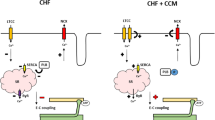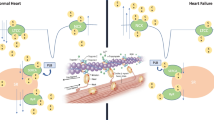Abstract
Purpose of review
Device-based therapy utilizing cardiac contractility modulation (CCM™) was approved by the FDA in March 2019 for patients with moderately to severely symptomatic heart failure with reduced ejection fraction between 25 and 45% on optimal guideline-directed medical therapy in normal sinus rhythm and not a candidate for cardiac resynchronization therapy. This review explores the mechanism of action behind CCM, the most recent clinical trials, and the expansion of therapy to additional patient populations.
Recent findings
The most recent trial on CCM explored a two-lead system, which was as equally efficacious as three-lead model. Importantly, CCM was shown to be effective in patients with atrial fibrillation (AF), who made up 15% of the population studied. Furthermore, emerging data from the European Registry suggests improvement in mortality with the use of CCM.
Summary
New developments of a two-lead system have allowed for expansion into a broader array of patient populations, including those with AF, while maintaining the safety and efficacy of this therapy.


Similar content being viewed by others
References and Recommended Reading
Papers of particular interest, published recently, have been highlighted as: •• Of major importance
Benjamin EJ, et al. Heart disease and stroke statistics-2017 update: a report from the American Heart Association. Circulation. 2017;135(10):e146–603.
Pfeffer MA, Shah AM, Borlaug BA. Heart failure with preserved ejection fraction in perspective. Circ Res. 2019;124(11):1598–617.
Higgins SL, et al. Cardiac resynchronization therapy for the treatment of heart failure in patients with intraventricular conduction delay and malignant ventricular tachyarrhythmias. J Am Coll Cardiol. 2003;42(8):1454–9.
Young JB, et al. Combined cardiac resynchronization and implantable cardioversion defibrillation in advanced chronic heart failure: the MIRACLE ICD Trial. JAMA. 2003;289(20):2685–94.
•• Abraham WT, et al. A randomized controlled trial to evaluate the safety and efficacy of cardiac contractility modulation. JACC Heart Fail. 2018;6(10):874–83 This publication outlines the results of the FIX-HF-5 clinical trial that confirmed the efficacy of CCM therapy in patients with EF 25–45% and QRS < 130 ms.
•• Mann JA, Abraham WT. Cardiac contractility modulation and baroreflex activation therapy in heart failure patients. Curr Heart Fail Rep. 2019;16(1):38–46 Excellent review which discusses newer device based therapies for the management of heart failure.
Kahwash R, Burkhoff D, Abraham WT. Cardiac contractility modulation in patients with advanced heart failure. Expert Rev Cardiovasc Ther. 2013;11(5):635–45.
Zile MR, et al. First granted example of novel FDA trial design under Expedited Access Pathway for premarket approval: BeAT-HF. Am Heart J. 2018;204:139–50.
Zile MR, et al. Baroreflex activation therapy in patients with heart failure with reduced ejection fraction. J Am Coll Cardiol. 2020;76(1):1–13.
Borggrefe MM, et al. Randomized, double blind study of nonexcitatory cardiac contractility modulation electrical impulses for symptomatic heart failure. Eur Heart J. 2008;29:1019–28.
Kadish A, et al. A randomized controlled trial evaluating the safety and efficacy of cardiac contractility modulation in advanced heart failure. Am Heart J. 2011;161(2):329–37 e1–2.
Abraham WT, et al. A randomized controlled trial to evaluate the safety and efficacy of cardiac contractility modulation in patients with systolic heart failure: rationale, design, and baseline patient characteristics. Am Heart J. 2008;156(4):641–648.e1.
Ponikowski P, et al. ESC Guidelines for the diagnosis and treatment of acute and chronic heart failure. Rev Esp Cardiol (Engl Ed), 2016. 2016;69(12):1167.
Seferovic PM, et al. Clinical practice update on heart failure 2019: pharmacotherapy, procedures, devices and patient management. An expert consensus meeting report of the Heart Failure Association of the European Society of Cardiology. Eur J Heart Fail. 2019;21(10):1169–86.
Wood EH, Heppner RL, Weidmann S. Inotropic effects of electric currents. I. Positive and negative effects of constant electric currents or current pulses applied during cardiac action potentials. II. Hypotheses: calcium movements, excitation-contraction coupling and inotropic effects. Circ Res. 1969;24(3):409–45.
Packer M, et al. Effect of oral milrinone on mortality in severe chronic heart failure. The PROMISE Study Research Group. N Engl J Med. 1991;325(21):1468–75.
Burkhoff D, et al. Electric currents applied during the refractory period can modulate cardiac contractility in vitro and in vivo. Heart Fail Rev. 2001;6(1):27–34.
Sabbah HN, et al. Cardiac contractility modulation with the impulse dynamics signal: studies in dogs with chronic heart failure. Heart Fail Rev. 2001;6(1):45–53.
Mohri S, et al. Cardiac contractility modulation by electric currents applied during the refractory period. Am J Physiol Heart Circ Physiol. 2002;282(5):H1642–7.
Morita H, et al. Long-term effects of non-excitatory cardiac contractility modulation electric signals on the progression of heart failure in dogs. Eur J Heart Fail. 2004;6(2):145–50.
Winter J, Brack KE, Ng GA. The acute inotropic effects of cardiac contractility modulation (CCM) are associated with action potential duration shortening and mediated by beta1-adrenoceptor signalling. J Mol Cell Cardiol. 2011;51(2):252–62.
Imai M, et al. Therapy with cardiac contractility modulation electrical signals improves left ventricular function and remodeling in dogs with chronic heart failure. J Am Coll Cardiol. 2007;49(21):2120–8.
Butter C, et al. Enhanced inotropic state of the failing left ventricle by cardiac contractility modulation electrical signals is not associated with increased myocardial oxygen consumption. J Card Fail. 2007;13(2):137–42.
Gupta RC, et al. Cardiac contractility modulation electrical signals normalize activity, expression, and phosphorylation of the Na + -Ca2+ exchanger in heart failure. J Card Fail. 2009;15(1):48–56.
Goliasch G, et al. The effect of device-based cardiac contractility modulation therapy on myocardial efficiency and oxidative metabolism in patients with heart failure. Eur J Nucl Med Mol Imaging. 2012;39(3):408–15.
Brunckhorst CB, et al. Cardiac contractility modulation by non-excitatory currents: studies in isolated cardiac muscle. Eur J Heart Fail. 2006;8(1):7–15.
Mohri S, et al. Electric currents applied during refractory period enhance contractility and systolic calcium in the ferret heart. Am J Physiol Heart Circ Physiol. 2003;284(4):H1119–23.
Abraham WT, et al. Subgroup analysis of a randomized controlled trial evaluating the safety and efficacy of cardiac contractility modulation in advanced heart failure. J Card Fail. 2011;17(9):710–7.
Marks AR. Calcium cycling proteins and heart failure: mechanisms and therapeutics. J Clin Invest. 2013;123(1):46–52.
Erickson JR, et al. CaMKII in the cardiovascular system: sensing redox states. Physiol Rev. 2011;91(3):889–915.
Kho C, et al. SUMO1-dependent modulation of SERCA2a in heart failure. Nature. 2011;477(7366):601–5.
Butter C, et al. Cardiac contractility modulation electrical signals improve myocardial gene expression in patients with heart failure. J Am Coll Cardiol. 2008;51(18):1784–9.
Rastogi S, et al. Effects of chronic therapy with cardiac contractility modulation electrical signals on cytoskeletal proteins and matrix metalloproteinases in dogs with heart failure. Cardiology. 2008;110(4):230–7.
Gupta RC, et al. Ca(2+)-binding proteins in dogs with heart failure: effects of cardiac contractility modulation electrical signals. Clin Transl Sci. 2009;2(3):211–5.
Kloppe A, et al. A randomized comparison of 5 versus 12 h per day of cardiac contractility modulation treatment for heart failure patients: a preliminary report. Cardiol J. 2016;23(1):114–9.
Lawo T, et al. Electrical signals applied during the absolute refractory period: an investigational treatment for advanced heart failure in patients with normal QRS duration. J Am Coll Cardiol. 2005;46(12):2229–36.
Pappone C, et al. First human chronic experience with cardiac contractility modulation by nonexcitatory electrical currents for treating systolic heart failure: mid-term safety and efficacy results from a multicenter study. J Cardiovasc Electrophysiol. 2004;15(4):418–27.
Stix G, et al. Chronic electrical stimulation during the absolute refractory period of the myocardium improves severe heart failure. Eur Heart J. 2004;25(8):650–5.
Neelagaru SB, et al. Nonexcitatory, cardiac contractility modulation electrical impulses: feasibility study for advanced heart failure in patients with normal QRS duration. Heart Rhythm. 2006;3(10):1140–7.
•• Wiegn P, et al. Safety, performance, and efficacy of cardiac contractility modulation delivered by the 2-lead Optimizer Smart System: the FIX-HF-5C2 study. Circ Heart Fail. 2020;13(4):e006512 This publication outlines the safety and efficacy of the 2-Lead Optimizer Smart System and extending the CCM therapy benefit to patients in atrial fibrillation.
•• Anker SD, et al. Cardiac contractility modulation improves long-term survival and hospitalizations in heart failure with reduced ejection fraction. Eur J Heart Fail. 2019;21(9):1103–13 This publication discusses possible post-market CCM mortality and morbidity benefits.
Kahwash R and Weiss R. Post approval study (PAS) of the OPTIMIZER Smart and CCM therapy (PAS). 2019.
Abraham WT, et al. A randomized controlled trial to evaluate the safety and efficacy of cardiac contractility modulation in patients with moderately reduced left ventricular ejection fraction and a narrow QRS duration: study rationale and design. J Card Fail. 2015;21(1):16–23.
Witte K, et al. Cost-effectiveness of a cardiac contractility modulation device in heart failure with normal QRS duration. ESC Heart Fail. 2019;6(6):1178–87.
Jessup M, et al. 2009 focused update: ACCF/AHA Guidelines for the Diagnosis and Management of Heart Failure in Adults: a report of the American College of Cardiology Foundation/American Heart Association Task Force on Practice Guidelines: developed in collaboration with the International Society for Heart and Lung Transplantation. Circulation. 2009;119(14):1977–2016.
Röger S, et al. Cardiac contractility modulation: first experience in heart failure patients with reduced ejection fraction and permanent atrial fibrillation. Europace. 2014;16(8):1205–9.
Tschöpe C, et al. Heart failure with preserved ejection fraction: current management and future strategies: expert opinion on the behalf of the nucleus of the “Heart Failure Working Group” of the German Society of Cardiology (DKG). Clin Res Cardiol. 2018;107(1):1–19.
Tschöpe C, et al. Cardiac contractility modulation signals improve exercise intolerance and maladaptive regulation of cardiac key proteins for systolic and diastolic function in HFpEF. Int J Cardiol. 2016;203:1061–6.
Tschöpe C, et al. Cardiac contractility modulation: mechanisms of action in heart failure with reduced ejection fraction and beyond. Eur J Heart Fail. 2019;21(1):14–22.
Tint, D., R. Florea, and S. Micu, New generation cardiac contractility modulation device-filling the gap in heart failure treatment. J Clin Med, 2019. 8(5).
Optimizer smart system sponsor executive summary. 2018: FDA.gov. Accessed 18 Aug 2020.
Funding
Dr. Campbell reports grants from National Center for Advancing Translational Sciences (TL1TR002735)/NIH, during the conduct of the study.
Author information
Authors and Affiliations
Corresponding author
Ethics declarations
Conflict of interest
Alexis Barnes declares that has has no conflict of interest.
Courtney Campbell declares that he has no conflict of interest.
Raul Weiss declares that he has no conflict of interest.
Rami Kahwash declares that he has no conflict of interest.
Human and animal rights and informed consent
This article does not contain any studies with human or animal subjects performed by any of the authors.
Additional information
Publisher’s Note
Springer Nature remains neutral with regard to jurisdictional claims in published maps and institutional affiliations.
This article is part of the Topical Collection on Heart Failure
Rights and permissions
About this article
Cite this article
Barnes, A., Campbell, C., Weiss, R. et al. Cardiac Contractility Modulation in Heart Failure: Mechanisms and Clinical Evidence. Curr Treat Options Cardio Med 22, 43 (2020). https://doi.org/10.1007/s11936-020-00852-8
Accepted:
Published:
DOI: https://doi.org/10.1007/s11936-020-00852-8




